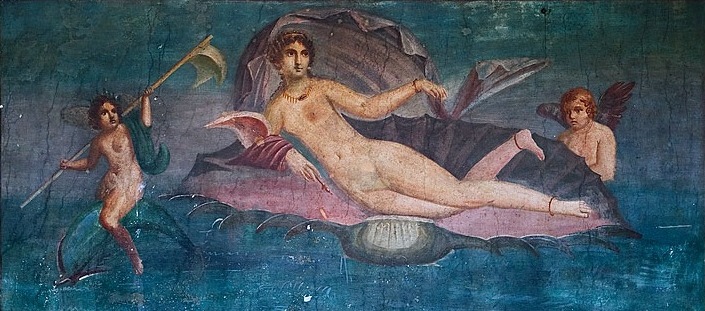Ἀφροδίτη Ἀναδυομένη

Apelles of Kos (4th century BC) painted the birth of Venus rising from the ‘foam of the sea’. It immediately became a legendary paiting. It was moved to Rome by the Emperor August. However, when the historian Plinius sr. saw it in the first century AD, it was already much deteriorated.
The painting itself does not survive, but this wallpainting in Pompei (‘House of Venus’) is supposed to be based on it. Looking at it, it is clear Botticelli was also inspired by this painting. His birth of Venus can be considered a reconstruction (re-invention, imitatio, and of course: emulatio).
About Apelles many stories circulate (mainly based on Pliny’s account in book XXXV of his world history (Historia Naturalis)), all referring to the highly realistic way he represented the subject. People wanting to touch the hair of Venus (still looking wet), or horses starting to neigh, seeing his painting of a horse. Horace in his Ars poetica attributes a similar power to poetry: ut pictura poesis. The legend itself inspired – of course – a number of poets. For instance in France: Clément Marot (for him see my website dedicated to him)
Here the poem (with translation and other poems inspired by it… There is no hors-texte).
Clement Marot: Rondeau LVI
A la fille d’ung Painctre d’Orleans, belle entre les autres
Au temps passé Apelles Painctre sage
Feit seullement de Venus le visage
Par fiction: mais (pour plus hault attaindre)
Ton Pere a faict de Venus (sans rien faindre)
Entierement la face, et le corsage.
Car il et Painctre, et tu es son ouvrage
Mieulx ressemblant Venus de forme, et d’aage,
Que le Tableau, qu’Apelle voulut paindre
Au temps passé.
Vray est qu’il feit si belle son ymage,
Qu’elle eschauffoit en Amour maint courage;
Mais celle là que ton Pere a sceu taindre,
Y mect le feu, et a dequoy l’estaindre:
L’aultre n’eut pas ung si gros advantage
Au temps passé.
Translation: In times past, Apelles, clever painter / represented only Venus’s face / through his art, but (to achieve higher things) / your father made Venus (without feigning anything) / face and bust alike. // For he is a painter and you are his work / better resembling Venus in shape and age / than the painting Apelles wanted to paint / in times past. // True it is that he made his image so beautiful / that it enflamed with love many a heart; / this one which your Father knew how to brush, / lights up the fire here and has something to quench it. / The former had no such advantage / in times past.
Latin
Ad puellam, ex vulgari carmine Maroti, Borbonius scripsit
Olim qui Veneris vultum depinxit Apelles,
Maximus, & primus fertur in arte sua.
Ecce tamen genitor tuus est praestantior illo,
Cuius peniculo facta puella Dea es.
Illa quidem multos urebat Apellis imago,
Atque aliquot iuvenes cepit amore sui.
Non habuit tamen unde suos restingueret ignes:
Tu simul inflammas, & medicamen habes.
Translation
To the maiden – from the vernacular by Marot – Nicolas Bourbon (= Marot’s friend, a famous Neo-Latin poet).
“Until now, Apelles, who painted the face of Venus, was forever held to be the greatest and foremost in his art. Yet, behold, your father is more outstanding than him, through whose brush you, a girl, have been made a Goddess. Indeed that image of Apelles set many aflame, and seized some young men with desire of itself. Yet it held not the wherewithal to quench their fires: but you both kindle and hold the cure.”
[for more info, see Andrew W. Taylor, “Between Surrey and Marot: Nicolas Bourbon and the Artful Translation of the Epigram”, in Translation and Literature 15.1 (2006) 1-20]
The key to understand this Rondeau is the story that in ancient times the legendary painter Apelles painted Venus so truthful, so real that suspicion arose that he must have really seen her. Marot nicely turns this legend in a compliment to a real woman, daugther of a painter, in which all the beauty of Venus is expressed, no fiction but reality. A Latin epigram by Théodore de Bèze takes up this legend to compliment Marot. De Bèze (Beza) wrote this epigram when he was still an adolescent (published in his Iuvenilia, 1548); Note the innuendo in the end.
Tam doctè Venerem divinus pinxit Apelles
Illi ut credatur visa fuisse Venus.
At tantam sapiunt Venerem tua scripta, Marote,
Ut tibi credatur cognita tota Venus.
Translation by John Weever, also 16th Century:
Apelles did so paint faire Venus Queene,
That most suppos’de he had faire Venus seene,
But thy bald rimes of Venus savour so.
That I dare sweare thou dost all Venus know.
